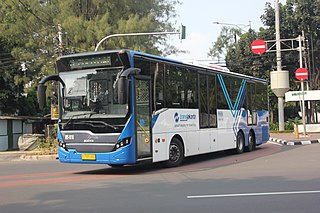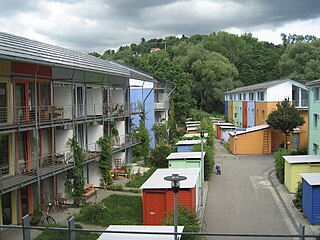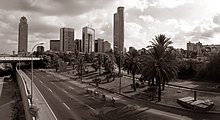
Reclaim the Streets also known as RTS, are a collective with a shared ideal of community ownership of public spaces. Participants characterise the collective as a resistance movement opposed to the dominance of corporate forces in globalisation, and to the car as the dominant mode of transport.

Bogotá, officially Bogotá, Distrito Capital, abbreviated Bogotá, D.C., and formerly known as Santa Fe de Bogotá during the Spanish Colonial period and between 1991 and 2000, is the capital and largest city of Colombia, and one of the largest cities in the world. The city is administered as the Capital District, as well as the capital of, though not part of, the surrounding department of Cundinamarca. Bogotá is a territorial entity of the first order, with the same administrative status as the departments of Colombia. It is the main political, economic, administrative, industrial, cultural, airport, technological, scientific, healthcare and educational center of the country and northern South America.

Bus rapid transit (BRT), also referred to as a busway or transitway, is a bus-based public transport system designed to have much more capacity, reliability and other quality features than a conventional bus system. Typically, a BRT system includes roadways that are dedicated to buses, and gives priority to buses at intersections where buses may interact with other traffic; alongside design features to reduce delays caused by passengers boarding or leaving buses, or paying fares. BRT aims to combine the capacity and speed of a light rail transit (LRT) or mass rapid transit (MRT) system with the flexibility, lower cost and simplicity of a bus system.

Pedestrian zones are areas of a city or town restricted to use by people on foot or human-powered transport such as bicycles, with non-emergency motor traffic not allowed. Converting a street or an area to pedestrian-only use is called pedestrianisation.

The car-free movement is a broad, informal, emergent network of individuals and organizations, including social activists, urban planners, transportation engineers, environmentalists and others, brought together by a shared belief that large and/or high-speed motorized vehicles are too dominant in most modern cities. The goal of the movement is to create places where motorized vehicle use is greatly reduced or eliminated, by converting road and parking space to other public uses and rebuilding compact urban environments where most destinations are within easy reach by other means, including walking, cycling, public transport, personal transporters, and mobility as a service.

Sustainable transport refers to ways of transportation that are sustainable in terms of their social and environmental impacts. Components for evaluating sustainability include the particular vehicles used for road, water or air transport; the source of energy; and the infrastructure used to accommodate the transport. Transport operations and logistics as well as transit-oriented development are also involved in evaluation. Transportation sustainability is largely being measured by transportation system effectiveness and efficiency as well as the environmental and climate impacts of the system. Transport systems have significant impacts on the environment, accounting for between 20% and 25% of world energy consumption and carbon dioxide emissions. The majority of the emissions, almost 97%, came from direct burning of fossil fuels. In 2019, about 95% of the fuel came from fossil sources. The main source of greenhouse gas emissions in the European Union is transportation. In 2019 it contributes to about 31% of global emissions and 24% of emissions in the EU. In addition, up to the COVID-19 pandemic, emissions have only increased in this one sector. Greenhouse gas emissions from transport are increasing at a faster rate than any other energy using sector. Road transport is also a major contributor to local air pollution and smog.

The Think City is an electric city car that was produced by Norwegian carmaker Think Global, and production partner Valmet Automotive from 2008 to 2012. It is a small two-seater/2+2-seater highway capable vehicle, with a top speed of 110 kilometres per hour (68 mph), and an all-electric range of 160 kilometres (99 mi) on a full charge.

Ciclovía, also ciclovia or cyclovia, is a Spanish term that means "cycleway", either a permanent bike path or the temporary closing of certain streets to automobiles for cyclists and pedestrians, a practice sometimes called open streets.

A carfree city is an urban area absent of motor vehicles. Carfree cities rely on public transport, walking, and cycling for travel as opposed to motor vehicles. Districts where motor vehicles are prohibited are referred to as carfree zones. Carfree city models have gained traction in the second half of the 20th century due to issues with congestion and infrastructure, and proposed environmental and quality of life benefits. Many cities in Asia, Europe, and Africa have carfree areas due to the cities being created before the invention of motor vehicles, while many developing cities in Asia are using the carfree model to modernize their infrastructure.
Francis Eric Knight Britton was an American political scientist and sustainability activist who has lived and worked in Paris, France, since 1969. As the main convenor of The Commons: Open Society Sustainability Initiative and its various networks, he is well known for promoting integrated public transport, carsharing and bike sharing.
The World Carfree Network (WCN) is an international network that coordinates the actions of car-free advocates from around the world. It is the main hub of the global car-free movement. The World Carfree Network brings together roughly 90-member organisations and many more individuals dedicated to promoting alternatives to car dependence and automobile-based planning at the international level. Working to reduce the human impact on the natural environment while improving the quality of life for all are major goals.

Road space rationing, also known as alternate-day travel, driving restriction and no-drive days, is a travel demand management strategy aimed to reduce the negative externalities generated by urban air pollution or peak urban travel demand in excess of available supply or road capacity, through artificially restricting demand by rationing the scarce common good road capacity, especially during the peak periods or during peak pollution events. This objective is achieved by restricting traffic access into an urban cordon area, city center (CBD), or district based upon the last digits of the license number on pre-established days and during certain periods, usually, the peak hours.

A pedestrian village is a compact, pedestrian-oriented neighborhood or town with a mixed-use village center. Shared-use lanes for pedestrians and those using bicycles, Segways, wheelchairs, and other small rolling conveyances that do not use internal combustion engines. Generally, these lanes are in front of the houses and businesses, and streets for motor vehicles are always at the rear. Some pedestrian villages might be nearly car-free with cars either hidden below the buildings, or on the boundary of the village. Venice, Italy is essentially a pedestrian village with canals. Other examples of a pedestrian village include Giethoorn village located in the Dutch province of Overijssel, Netherlands, Mont-Tremblant Pedestrian Village located beside Mont-Tremblant, Quebec, Canada, and Culdesac Tempe in Tempe, Arizona.
Bicycology is a UK-based collective that was formed after the 2005 London to Scotland G8 Bike Ride. It is a non-hierarchical non-profit organisation which aims to promote cycling as part of a wider focus on social and environmental sustainability. Bicycology has received funding from Artists Project Earth and is a member organisation of the World Carfree Network.

Vauban is a neighbourhood (Stadtteil) to the south of the town centre in Freiburg, Germany. It was built as "a sustainable model district" on the site of a former French military base named after Sébastien Le Prestre de Vauban, the 17th century French Marshal who built fortifications in Freiburg while the region was under French rule. Construction began in 1998, and the first two residents arrived in 2001.

Atlanta Streets Alive is a ciclovía held throughout the year in Atlanta, Georgia, United States. Ciclovía is Spanish for a temporary closing of the street to automobiles for use by people participating in recreational activity. Organized by the Atlanta Bicycle Coalition, Atlanta Streets Alive opens streets for people in the city of Atlanta by temporarily closing them to cars to create a whole new healthy, sustainable and vibrant city street experience. People can walk, bike, roller-skate, jog, skip and roll down 3 to 5 miles of major thoroughfares that have been closed to cars throughout Atlanta three or four times a summer. Throughout the route there are activities and examples of tactical urbanism inspired to help citizens envision shared streets. In 2018, the Atlanta Bicycle Coalition connected the routes for Atlanta Streets Alive with their street campaigns to drive energy towards demanding more complete and shared streets in the city of Atlanta.

Mia Electric was a French electric car manufacturer in the 2010s. The company, based in Cerizay, France, designed and built electric vehicles made totally in France.

Paris–Rouen, Le Petit Journal Horseless Carriages Contest, was a pioneering city-to-city motoring competition in 1894 which is sometimes described as the world's first competitive motor race.

The People's Climate March (PCM) was a large-scale activist event orchestrated by the People's Climate Movement to advocate global action against climate change, which took place on Sunday, September 21, 2014, in New York City, along with a series of companion actions worldwide, many of which also took the name People's Climate March. With an estimated 311,000 participants, the New York event was the largest climate change march in history. Described as "an invitation to change everything," the march was called in May 2014 by the global advocacy human rights group Avaaz and 350.org, the environmental organization founded by writer/activist Bill McKibben, and it was endorsed by "over 1,500 organizations, including many international and national unions, churches, schools and community and environmental justice organizations." It was conceived as a response to the scheduled U.N. Climate Summit of world leaders to take place in New York City two days later, on September 23.























